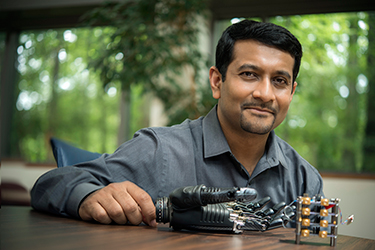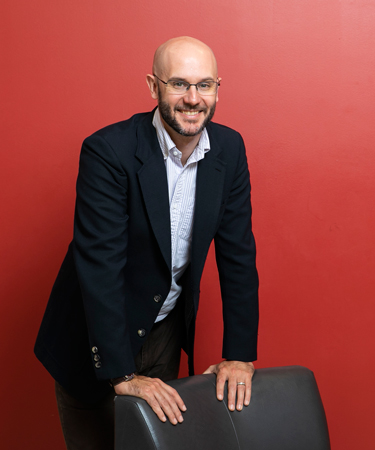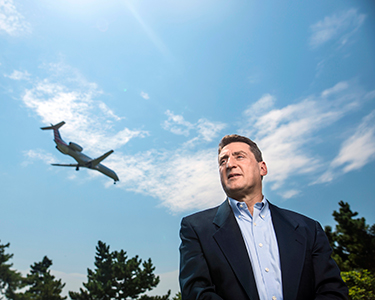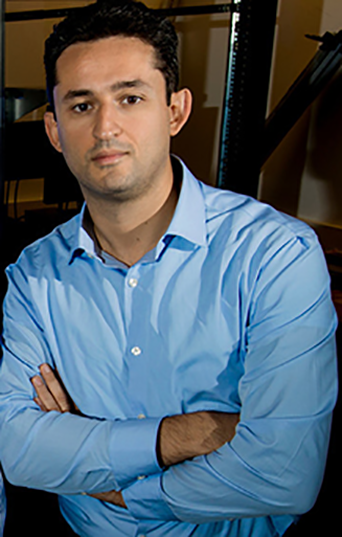
Bioengineering professor Siddhartha Sikdar is continuing his research on controlling prostheses using ultrasound waves to sense muscle activity. His team is working remotely on software development, as well as some portions of testing and evaluation tasks.
George Mason University recently suspended almost all research activities conducted in its labs and facilities amid the coronavirus outbreak, but innovative Mason Engineering researchers are finding ways to continue their work remotely.
Many will use the next few months to do computer-based work, conduct portions of studies at home, and write papers about results.
For example, bioengineering professor Siddhartha Sikdar is using up-to-date technology to help individuals with limb loss better control their prostheses. His team is investigating a new way to operate prostheses using ultrasound waves to sense muscle activity.
The research group was recently awarded a Bioengineering Research Partnership grant from the National Institutes of Health (NIH) to develop this technology for commercial use and perform clinical trials in subjects. The project was just ramping up when the lab had to close. However, the team has developed plans to continue making progress remotely.
“Our NIH grant has a strict schedule of milestones, but we were able to re-prioritize some of the tasks that were more focused on software development, which can be easily done remotely,” Sikdar says. “We are also going to be able to continue some portions of our testing and evaluation tasks remotely.”
His graduate students are building temporary workstations at home with test equipment from the lab to continue testing prototypes. The students and trainees will also work on analyzing data that has been collected and continue working on journal papers, he says.
The group will have weekly WebEx meetings with their industry collaborators and are using project management software to continue their progress and ensure effective collaboration among the team, Sikdar says.
His other projects, including a Department of Defense-funded project, had ongoing clinical studies, which have been temporarily paused. Students will continue analyzing the collected data and refine data-collection protocols so activities can resume as soon as the lab reopens, he says.

Remi Veneziano, an assistant professor in the Department of Bioengineering, and his research team are using software that allows 3D designs and renderings to explore new DNA nanoparticle architectures. These will be used for vaccine platforms development and other biomedical applications.
Laying the foundation for future lab work
Remi Veneziano, an assistant professor in the Department of Bioengineering, is using DNA nanotechnology to lay the foundation for developing vaccines that could fight viruses such as the coronavirus.
Although his lab is closed, some graduate students are using software that allows 3D designs and renderings to explore new DNA nanoparticle architectures. These will be used for vaccine platforms development and other biomedical applications, Veneziano says.
“In bioengineering, especially nanotechnology-based research, there is always a step of design that doesn't require experimental work, and we decided to focus on this specific aspect and explore new potential projects,” he says.
The research group is also writing protocols, defining plans for future experiments, and working on papers to report the results they’ve generated in the past year, he says. “This will help to ensure research continuity and enable us to be ready to dive right into new experiments when we’re back in the lab.”

Feitian Zhang, an assistant professor of electrical and computer engineering, says his research is shifting from robotic fish development and testing to computer-based design, simulation, and writing papers.
Making the most of computer-based design
The work of Electrical and Computer Engineering Assistant Professor Feitian Zhang involves creating robotic fish that can navigate water through wireless commands. The robots are equipped with sensors that can collect data on temperature, algae, dissolved oxygen content, and oil.
“My research group will continue the research with each individual working at home,” he says. “That’s very challenging for us because we develop hardware-focused robots. The focus shifts from robot development and testing to computer-based design, simulation, and writing papers. WebEx and emails will be used for updates and feedback.”

Dave Lattanzi, associate professor in the Sid and Reva Dewberry Department of Civil, Environmental, and Infrastructure Engineering, and his graduate students are now working remotely on a project called the “digital twin,” a complex virtual model that changes as U.S. Navy ships age to track their lifecycle monitoring and assessment. His students took the sensors, microcomputers, and small-scale structures to their homes, and they are building the systems there, turning their homes into micro-labs.
Creating micro-labs at home
Civil engineering associate professor Dave Lattanzi and his research group usually conduct lab and field experiments combined with computation/data analysis.
He’s working remotely with his graduate students on a project called the “digital twin,” a complex virtual model that changes as U.S. Navy ships age to track their lifecycle monitoring and assessment.
“The students took the sensors, microcomputers, and small-scale structures to their homes, and they are building the systems there, turning their homes into micro-labs,” says Lattanzi, an associate professor in the Sid and Reva Dewberry Department of Civil, Environmental, and Infrastructure Engineering and John Toups Faculty Fellow.
Several members of his team are writing up their results and developing computer code. He holds weekly video meetings with each student, as well as a group meeting every other week. “This is what we’ve always done; we’re just doing it virtually now,” he says.
A few of his graduate research assistants are also developing machine learning/artificial intelligence algorithms. They don’t need specialized equipment; they can remotely access university computing resources, Lattanzi says.

Lance Sherry, an associate professor in the Department of Systems Engineering and Operations Research, is communicating daily with his team to continue several research projects including a study of air medical services as well as research on explainable artificial intelligence, climate change modeling, and autonomous vehicle traffic modeling.
Polishing video communication skills
Systems Engineering and Operations Research Associate Professor Lance Sherry and his students have several funded projects with deadlines and deliverables. A study of air medical services will continue without site visits. “We are rescheduling with video conferences," Sherry says.
Other research on explainable artificial intelligence, climate change modeling, and autonomous vehicle traffic modeling continues without interruption.
“The biggest difference is that Dr. Sherry used to come around every morning, and we discussed the results and the next steps," says graduate student Sasha Donnelly. “We would sketch ideas on the whiteboard. Now, we do it via a video-conference.”
While they have lost some of the give-and-take of in-person dialogue, “we are getting more sophisticated with video conferencing and using animations and other ways of communicating ideas,” says graduate student Jomana Bashata. “This is a great skill to develop … for the next step in our careers. The research sponsors have really liked it and are using it for their own presentations.”

Jill Nelson, an associate professor in the Department of Electrical and Computer Engineering, will be able to use data from Mason's recent switch to virtual learning for one of her research projects.
Gaining insights from online learning
Jill Nelson, an associate professor in the Department of Electrical and Computer Engineering and an award-winning instructor, is also continuing her research in two diverse areas.
She’s studying algorithms for making intelligent decisions about how to allocate resources in active sonar surveillance systems, as well as how communities of instructors, graduate teaching assistants, and undergraduate learning assistants can promote active-learning practices in entry-level college STEM courses, including calculus and physics.
Active learning is where students work to solve problems themselves in the classroom and learn from their mistakes, vs. watching the professor solve problems in a lecture format.
For the latter study, Mason’s recent switch to virtual learning could provide Nelson’s group with new data. “We’ll now be able to examine some interesting questions about those courses now that they’re online,” she says.
Much of her research is theoretical and/or computer-based, so working remotely isn’t a problem. The biggest change is how she communicates with collaborators and students.
“I no longer have the luxury of walking across the hall to talk to grad students or having regular coffee meetings with collaborators to discuss new ideas.”
She’s now communicating via email and conducting meetings virtually. “It’s far from a perfect substitute for face-to-face collaboration, so I look forward to the time when everyone can return to campus.”

Max Albanese, an associate professor in the Department of Information Sciences and Technology, continued to do cybersecurity research when the labs closed.
Preparing for Cyber Attacks
Massimiliano (Max) Albanese, a Mason Engineering cybersecurity researcher, has spent years studying the minds and methods of cybercriminals to develop better ways to defend computer systems.
When the Mason labs closed, he had done advance legwork so he could easily do his research remotely.
“I have systematically stored each and every file or dataset I need for my research and teaching in a cloud-based repository, such as Dropbox, Google Drive, or OneDrive. So, I was able to transition to remote work without having to move any data from my office computer,” says Albanese, an associate professor in the Department of Information Sciences and Technology (IST).
As associate director of the Center for Secure Information Systems, he’s working with researchers at various U.S. institutions to develop adaptive defenses against cyberattacks as part of a six-year, $6.75 million grant from the Department of Defense, and with researchers at Palo Alto Research Center (PARC), a Xerox Company, on configuration security as part of a project funded by DARPA.
“As cybersecurity researchers, we are fortunate because the resources we need for our research and to run experiments can be accessed remotely. Most of our servers are hosted in Mason’s central data center, located in the Aquia Building, so we are used to access those resources remotely, even when we are on campus,” he says.
“The ability to access your data and computational resources from anywhere is critical to efficiently and effectively move operations online in a situation like the one we are experiencing today.”
